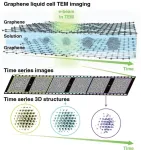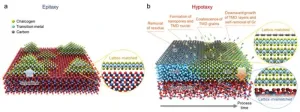(Press-News.org) A vivid new image is taking shape in the world of cell biology: Imagine bacteria adhering to the surface of a cell, perhaps at the site of an injury or wound. In response, a white blood cell arrives at the scene. This cell encircles the pathogen with its membrane, forming a tight, constricting ring. With remarkable force, the white blood cell yanks the pathogen off the wound’s surface. The white blood cell then engulfs the pathogen in a process called phagocytosis, in which it “eats” the foreign invader to neutralize it.
This dramatic process might sound like something out of a science fiction story.
“But it’s precisely what occurs inside our bodies,” said Xuefeng Wang, an associate professor at the University of Cincinnati’s Hoxworth Blood Center.
One key player in this process is integrin, a protein found on the surface of cells that facilitates adhesion, helping them stick to other surfaces. In this scenario, integrin is what the white blood cell actively works against when it pulls the pathogen away from the wound.
Wang’s biomedical research lab at Hoxworth focuses on understanding integrin and its role in cell biology. Notably, Hoxworth is the only blood center in the United States that houses an academic research arm, and Wang is one of two research professors on Hoxworth’s team.
Thanks to his work, Wang is now the recipient of a five-year, $2.3 million grant from the National Institutes of Health (NIH). This funding will support his lab's ongoing research into blood platelets and macrophages (a type of white blood cell). He will further investigate how integrin tension — the physical force exerted by this protein — influences cell function. Wang will also delve into how this force affects platelet behavior, particularly in the formation of clots to stop bleeding during injuries.
Editor's note: This grant was awarded before the current funding freeze went into effect.
Wang is the corresponding author of a study published recently in Nature Communications. The study highlights the newly discovered mechanism by which white blood cells use brute force to dislodge bacteria that stick to human tissues. Once detached, the white blood cells engulf and consume the pathogens.
This study was led by Wang, with Subhankar Kundu, a postdoctoral research fellow in his lab, serving as the first author. The research team also included Kaushik Pal and Arghajit Pyne, two other postdoctoral fellows in Wang's lab. Their collective work has far-reaching implications.
For example, consider the impact of environmental pollutants such as dust or smoke when they enter the lungs. These particles can adhere to lung tissue, and macrophages — the white blood cells responsible for cleaning up such intruders — are tasked with removing them. Macrophages dislodge the pollutants from the lung tissue and then ingest them, preventing harm to the respiratory system.
Looking ahead, Wang is hopeful that his research will contribute to the development of pharmaceuticals designed to enhance the ability of white blood cells to effectively target and neutralize pathogens.
“This research could open up novel treatments that not only combat infections but also accelerate the healing process of wounds,” said Wang, underscoring the real-world impact of his work.
END
White blood cells use brute force to dislodge bacteria
UC Hoxworth professor receives NIH grant for his lab’s biomedical research
2025-03-04
ELSE PRESS RELEASES FROM THIS DATE:
Foundation AI model predicts postoperative risks from clinical notes
2025-03-04
Millions of Americans undergo surgery each year. After surgery, preventing complications like pneumonia, blood clots and infections can be the difference between a successful recovery and a prolonged, painful hospital stay – or worse. More than 10% of surgical patients experience such complications, which can lead to longer stays in the intensive care unit (ICU), higher mortality rates and increased health care costs. Early identification of at-risk patients is crucial, but predicting these risks accurately remains ...
Brain functional networks adapt in response to surgery and Botox for facial palsy
2025-03-04
March 4, 2025 — For patients undergoing nerve transfer surgery for facial palsy, Botox injections can improve facial symmetry by reducing overactivity of the muscles on the unaffected side, suggests a study in the March issue of Plastic and Reconstructive Surgery®, the official medical journal of the American Society of Plastic Surgeons (ASPS). The journal is published in the Lippincott portfolio by Wolters Kluwer.
The added benefit of Botox reflects modifications ...
Multimodal AI tool supports ecological applications
2025-03-04
By Shawn Ballard
Ever seen an image of an animal and wondered, “What is that?” TaxaBind, a new tool developed by computer scientists in the McKelvey School of Engineering at Washington University in St. Louis, can sate that curiosity and more.
TaxaBind addresses the need for more robust and unified approaches to ecological problems by combining multiple models to perform species classification (what kind of bear is this?), distribution mapping (where are the cardinals?), and other tasks related to ecology. The tool can also be used as a starting point for larger studies related to ecological modeling, which scientists might use to predict shifts in plant and animal populations, ...
New University of Minnesota research shows impact of anxiety and apathy on decision-making
2025-03-04
MINNEAPOLIS/ST. PAUL (3/04/2025) — Making decisions in uncertain situations is part of daily life. New research from the University of Minnesota Medical School has uncovered that anxiety and apathy — two common but distinct emotional states — lead to fundamentally different patterns in how people learn and make decisions.
The findings were recently published in Biological Psychiatry: Cognitive Neuroscience and Neuroimaging.
The study investigated how anxiety and apathy — or a lack of interest and ...
Fred Hutch announces 10 recipients of the 2025 Harold M. Weintraub Graduate Student Award
2025-03-04
Fred Hutch Cancer Center announced 10 recipients of the annual Harold M. Weintraub Graduate Student Award, which recognizes the exceptional achievements of graduate studies in the biological sciences.
This year’s recipients represent both national and international research institutions, with a variety of thesis topics including the structural organization of neural networks, a hereditary basis for metastatic breast cancer, gene editing tools for neurodegenerative diseases and the brain’s ability to control the tongue.
“We congratulate the impressive group of domestic and international applicants this year ...
30 million euros for a novel method of monitoring the world's oceans and coastal regions using telecommunications cables
2025-03-04
Summary
The worldwide network of telecommunications cables lying on the bottom of the world's oceans offers unique potential for scientific use if the fibre-optic cables themselves are used as or equipped with sensors. Based on this, the GFZ Helmholtz Centre for Geosciences in Potsdam and the GEOMAR Helmholtz Centre for Ocean Research Kiel are now setting up the research infrastructure SAFAtor (SMART Cables And Fiber-optic Sensing Amphibious Demonstrator), that can be used to monitor the world's oceans. It will be included in the portfolio of the major Helmholtz infrastructures and funded by ...
New multicenter study shows: Which treatment helps best with high-risk acute pulmonary embolism
2025-03-04
A current study involving the University Hospital Bonn (UKB) has investigated which treatment strategy offers the best chances of survival in high-risk acute pulmonary embolism. The results, now published in the renowned journal "Intensive Care Medicine", provide crucial information for the future treatment of this life-threatening disease.
High-risk acute pulmonary embolism affects around five percent of all pulmonary embolisms and can take a dramatic course even in young people. Acute obstruction of the pulmonary circulation by a blood clot can lead to circulatory failure with a high mortality rate. The study, which was carried out in collaboration with 34 European centers ...
Hidden dangers and myths: What you need to know about HPV and cancer
2025-03-04
COLUMBUS, Ohio – While the human papillomavirus (HPV) is most associated with cervical cancer risk and women, a new survey commissioned by The Ohio State University Comprehensive Cancer Center – Arthur G. James Cancer Hospital and Richard J. Solove Research Institute (OSUCCC – James) shows that the majority of people are unaware that the virus is actually more common among men than women and is associated with rising rates of other cancers that directly impact men.
The consumer survey sought to understand the public’s knowledge of the lesser known but common virus – specifically how it is spread and its impact on cancer risk.
Survey ...
SNU researchers develop world’s first technology to observe atomic structural changes of nanoparticles in 3D
2025-03-04
Seoul National University College of Engineering announced that Professor Jungwon Park’s research team from the Department of Chemical and Biological Engineering has developed a groundbreaking technology to observe atomic structural changes of nanoparticles in three dimensions.
This study, recognized as a revolutionary achievement that resolves a long-standing challenge even past Nobel laureates could not solve, was published online in Nature Communications, one of the most prestigious international journals, on January 29.
Recently, nanoparticles have garnered significant attention as they are widely used in developing functional materials for cutting-edge industries ...
SNU researchers develop a new synthesis technology of single crystal 2D semiconductors, “Hypotaxy,” to enhance the commercialization of next-generation 2D semiconductors
2025-03-04
College of Engineering at Seoul National University announced that a research team led by Professor Gwan-Hyoung Lee from the Department of Materials Science and Engineering, in collaboration with the research teams of Professors Hyejin Jang and Jeong Woo Han from the same department, has successfully developed the new synthesis technology of 2D semiconductors. This groundbreaking technique enables the direct growth of wafer-scale single-crystal 2D semiconductors on various substrates.
The research were published in "Nature," the world's most ...
LAST 30 PRESS RELEASES:
Scalable and healable gradient textiles for multi‑scenario radiative cooling via bicomponent blow spinning
Research shows informed traders never let a good climate crisis go to waste
Intelligent XGBoost framework enhances asphalt pavement skid resistance assessment
Dual-function biomaterials for postoperative osteosarcoma: Tumor suppression and bone regeneration
New framework reveals where transport emissions concentrate in Singapore
NTP-enhanced lattice oxygen activation in Ce-Co catalysts for low-temperature soot combustion
Synergistic interface engineering in Cu-Zn-Ce catalysts for efficient CO2 hydrogenation to methanol
COVID-19 leaves a lasting mark on the human brain
Scientists use ultrasound to soften and treat cancer tumors without damaging healthy tissue
Community swimming program for Black youth boosts skills, sense of belonging, study finds
Specific depressive symptoms in midlife linked to increased dementia risk
An ‘illuminating’ design sheds light on cholesterol
Who is more likely to get long COVID?
Study showcases resilience and rapid growth of “living rocks”
Naval Research Lab diver earns Office of Naval Research 2025 Sailor of the Year
New Mayo-led study establishes practical definition for rapidly progressive dementia
Fossil fuel industry’s “climate false solutions” reinforce its power and aggravate environmental injustice
Researchers reveal bias in a widely used measure of algorithm performance
Alcohol causes cancer. A study from IOCB Prague confirms damage to DNA and shows how cells defend against it
Hidden viruses in wastewater treatment may shape public health risks, study finds
Unlock the power of nature: how biomass can transform climate mitigation
Biochar reshapes hidden soil microbes that capture carbon dioxide in farmland
Reducing saturated fat intake shows mortality benefit, but only in high-risk individuals
Manta rays create mobile ecosystems, study finds
Study: Mixed results in using lipoic acid to treat progressive multiple sclerosis
Norbert Holtkamp appointed director of Fermi National Accelerator Laboratory
New agentic AI platform accelerates advanced optics design
Biologists discover neurons use physical signals — not electricity — to stabilize communication
Researchers discover that a hormone can access the brain by hitchhiking
University of Oklahoma researcher awarded funding to pursue AI-powered material design
[Press-News.org] White blood cells use brute force to dislodge bacteriaUC Hoxworth professor receives NIH grant for his lab’s biomedical research


